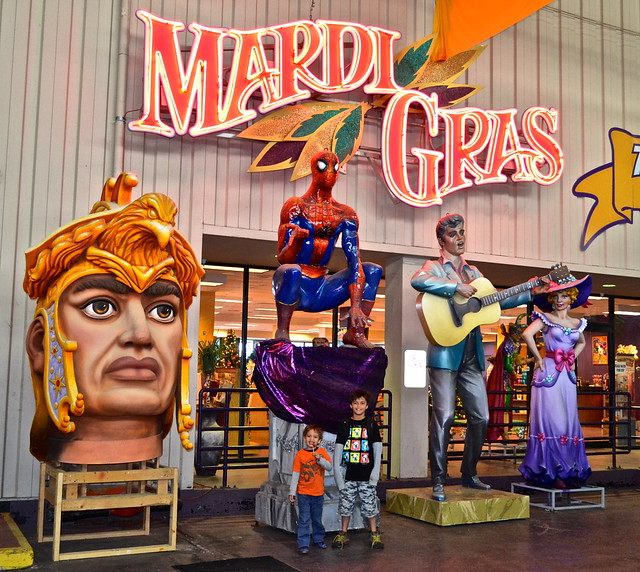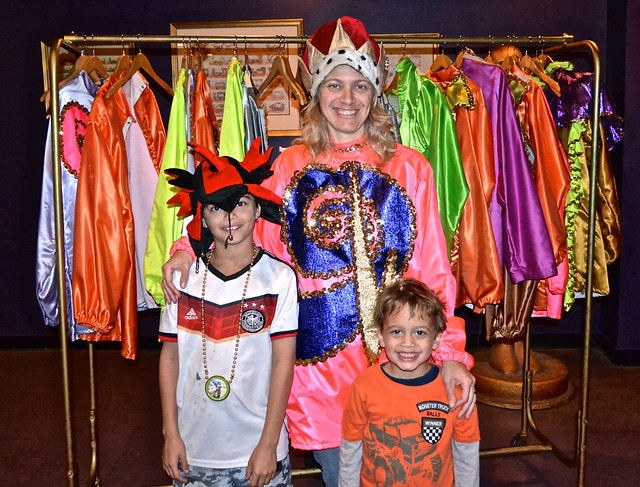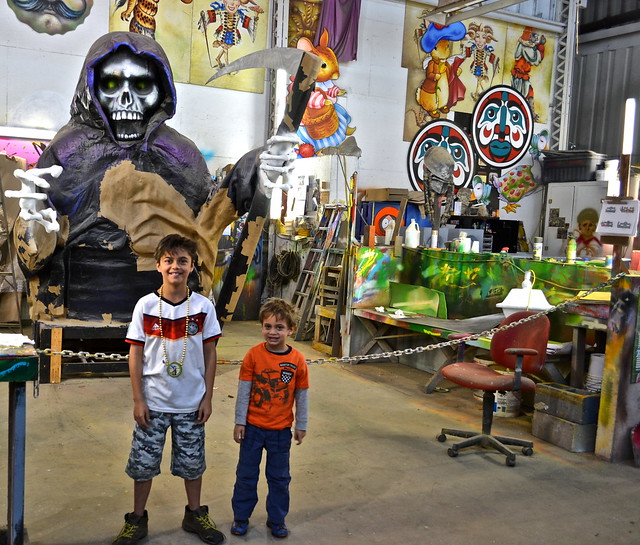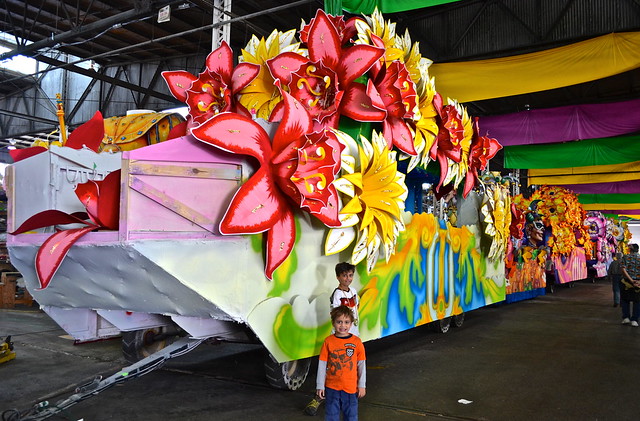Can’t make it to New Orleans during Mardi Gras? No sweat, you can do the next best thing. Visit Mardi Gras World.
I can sum up this place with one word – WOW!

Recommended Read: Things to do with kids in New Orleans
This attraction was one of the top recommendations by Sarah from New Orleans CVB, and good reason for it.
I’m not sure what I was expecting, but I wasn’t really expecting to see this humongous stadium-sized warehouse devoted to making Mardi Gras artworks and floats. Honestly, I always thought the individual organizations who participated in Mardi Gras made their own. So this turned out to be a great educational trip on top of the scenic for my boys and me.

What is Mardi Gras World?
1. This is not just an exhibit hall, but a full-on working factory. Artists, carpenters, sculptors, designers, and many more people work here year-round.
2. The only time Mardi Gras World is closed is – obviously – during Mardi Gras (which changes dates every year due to Easter dates).
3. Mardi Gras World provides visitors with the opportunity to see authentic Mardi Gras costumes and tour the enormous warehouses filled with floats.

4. The tour, which is included in your entrance fee, includes a short video of how Mardi Gras started and how Mardi Gras World began. And then a guide takes you to see the warehouse and work area.

5. You can do this on your own, but you really won’t get the history and fun facts of it. If you want, you are welcome to stay as long as you want after the tour is over.

6. The whole tour is about 45 minutes long
7. There is a free Mardi Gras shuttle that picks you up at a pickup station and then afterward brings you back to your hotel
Recommended Read: New Orleans History
Fun Facts and History of Mardi Gras World

- More than 80 percent of the floats that journey down New Orleans’ streets during the Carnival season are designed and built here.
- It all began in 1947 by float designer and builder Blaine Kern. Interestingly enough, Blaine was simply an out-of-work artist who started helping with the floats, until someone loved his work so much, and he was getting more and more requests
- In 1984, Mardi Gras World was created as a tourist attraction to show visitors a behind-the-scenes look at float building
- They create floats for over 40 parades from all over the world.

Video Fun
Mardi Gras Festival History and Facts
History of Mardi Gras
- The origins of Mardi Gras can be traced back to Rome, which was later transferred to medieval Europe.
- During the 17th and 18th centuries Venice and the French House of the Bourbons celebrated this festival. From here, the traditional revelry of “Boeuf Gras,” or fatted calf, was introduced to the French colonies.
- On March 2, 1699, French-Canadian explorer Jean Baptiste Le Moyne Sieur de Bienville arrived south of New Orleans, and named it “Pointe du Mardi Gras” because he and his crew arrived on the eve of the festive holiday.
- Bienville also established “Fort Louis de la Louisiane” (which is now in Mobile) in 1702.
- The next year the settlement of Fort Louis de la Mobile celebrated America’s very first Mardi Gras.
- In 1704, Mobile established a secret society (Masque de la Mobile), similar to those that form the current Mardi Gras krewes. It lasted for five years.
- In 1710, the “Boeuf Gras Society” was formed and paraded from 1711 through 1861.
- By the 1730s, Mardi Gras was celebrated openly in New Orleans.
- In the early 1740s, Louisiana’s governor, the Marquis de Vaudreuil, established elegant society balls, which became the model for the New Orleans Mardi Gras balls of today.
- The earliest reference to Mardi Gras “Carnival” appears in a 1781 report to the Spanish colonial governing body.
- By the late 1830s, New Orleans held street processions of maskers with carriages and horseback riders to celebrate Mardi Gras.
- In 1856, six young Mobile natives formed the Mistick Krewe of Comus, invoking John Milton’s hero Comus to represent their organization.
- In 1870, Mardi Gras’ second Krewe, the Twelfth Night Revelers, was formed. This is also the first recorded account of Mardi Gras “throws.”
- Each of these designers’ works was brought to life by Parisian paper-mache’ artist Georges Soulie’, who for 40 years was responsible for creating all of Carnival’s floats and processional outfits.
- 1872 was the year that a group of businessmen invented a King of Carnival, Rex, to preside over the first daytime parade. They did this as a way to honor the visiting Russian Grand Duke Alexis Romanoff
- This was also the Mardi Gras season that Carnival’s improbable anthem, “If Ever I Cease to Love,” was cemented, due in part to the Duke’s fondness for the tune.
- In 1783, floats began to be constructed entirely in New Orleans instead of France.
- In 1875, Governor Warmoth signed the “Mardi Gras Act,” making Fat Tuesday a legal holiday in Louisiana.
The Facts
- Popular practices on Mardi Gras include wearing masks and costumes, overturning social conventions, dancing, sports competitions, parades, debauchery, etc.
- Mardi Gras, also called Fat Tuesday, is the name given to the Carnival celebrations, beginning on or after the Epiphany or King’s Day and culminating on the day before Ash Wednesday.
- Mardi Gras is French for “Fat Tuesday”, it was a day when ancient Romans had the last chance of eating richer, fatty foods before the ritual fasting of the Lenten season.
- Celebrations are concentrated for about two weeks before and through Fat Tuesday.
- Usually, there is one major parade each day (weather permitting); many days have several large parades. The largest and most elaborate parades take place during the last five days of the season.
- The parades in New Orleans are organized by Carnival krewes.
- Krewe float riders toss throws to the crowds. The most common throws are strings of colorful plastic beads, doubloons (aluminum or wooden dollar-sized coins usually impressed with a krewe logo), decorated plastic throw cups, and small inexpensive toys.

Recommended Read: Tips for visiting New Orleans with Kids
Information for Visiting Mardi Gras World
Address: 1380 Port of New Orleans Place, New Orleans, LA 70130
Phone: 504-361-7821
Prices
- Adults and children $19.95
- Seniors, 65+ $15.95
- Students with college ID $15.95
- Children, 2-11 $12.95
Hours: 7 days a week, from 9:30 am to 5:30 pm. The last tour begins at 4:30 pm.
The post New Orleans Mardi Gras World Review – A Must Visit appeared first on Travel Experta - Travel, Lifestyle, Freedom.
------------------------------------------
By: Marina 'Travel Experta'
Title: New Orleans Mardi Gras World Review – A Must Visit
Sourced From: travelexperta.com/mardi-gras-world-new-orleans/
Published Date: Mon, 06 Mar 2023 11:55:50 +0000






